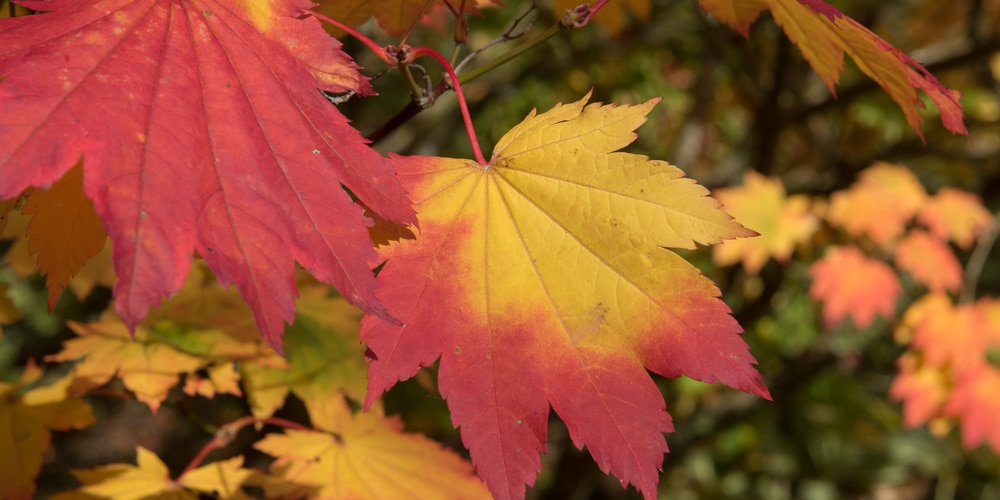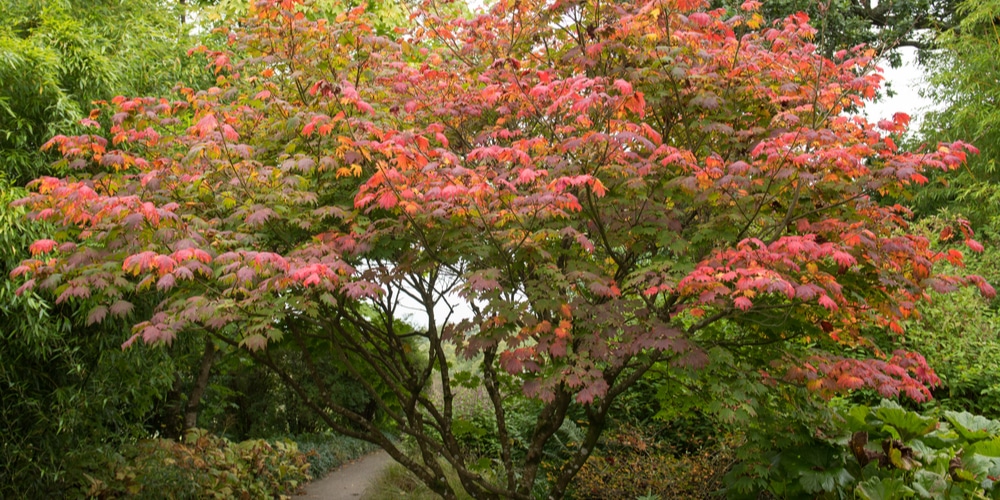Acer japonicum, also called full moon maple, is a beautiful medium-sized deciduous tree prized for its eye-catching foliage. It is native to Japan, Korea, and China, growing in forested areas.
The tree has a rounded form and typically reaches 10-15 feet tall and wide at maturity, although some specimens can grow larger.
| Botanical Name | Acer japonicum ‘Vitifolium’ |
| Common Name | Full Moon Maple |
| Plant Type | Perennial |
| Flower Color | Purple, orange, and crimson red flowers that bloom in spring |
| Size When Mature | 120 – 180 inches tall |
| Bloom Time | Early Spring |
| Sun Requirements | Full sun, tolerates partial shade |
| USDA Hardiness Zones | 5 – 7 |
| Soil PH Range | 5.0 – 7.0 |
| Soil Type | Acidic to neutral, moist, well-draining soil |
| Water Needs | Medium |
| Native Area | Japan |
What You Need to Know About Acer Japonicum
Acer japonicum is a deciduous tree that is native to Japan. It typically grows to a height of 20-30 feet and has oval-shaped leaves 6-8 inches long. It has stunning five-lobed leaves with deep green foliage that turn a gorgeous purple, crimson red, and orange in the fall.
The tree is a popular choice for landscapes due to its beautiful fall color and attractive form. It has small gorgeous flowers appearing during the springtime, which turn into winged fruits called samaras that are about an inch long. The samaras ripen in the fall and are brown in color with a papery texture.
Despite its beauty, Acer japonicum is not without its challenges. The tree is susceptible to several diseases and pests, although they’re relatively easy to care for given the right conditions.
How to Care for Acer Japonicum
Here’s everything you need to know about growing and caring for a thriving Acer japonicum tree:
Light
When planting Acer japonicum, it’s crucial to choose a location that gets full sun. The tree does best in bright, direct sunlight and can tolerate partial shade. This sun-loving tree needs at least six hours of sunlight per day to thrive.
Water and Soil Needs
Full moon maple tree grows best in well-drained, moist soil, with a soil pH of 6.0-7.5. It particularly likes its soil to be slightly acidic. The tree is tolerant of a wide range of soil types, including clay and sand.
When watering, be sure to keep the soil moist but not soggy. This means watering deeply and regularly, especially during periods of hot, dry weather. Mulching around the base of the tree will help to retain moisture in the soil.
Temperature Requirements
This gorgeous tree is hardy in USDA zones 5-7, which means it can tolerate temperatures as low as -20 degrees Fahrenheit. This tree is famous for its attractive foliage and compact growth habit, but it is also known for its ability to withstand cold winter temperatures.
However, the tree needs to be protected from cold winds and frost during winter. Acer japonicum is reasonably tolerant of urban pollution and salt spray, making it a good choice for planting near roads and highways.
Fertilizer
The best fertilizer to use on an Acer japonicum tree is high in phosphorous. This will help to encourage strong root growth and promote healthy blooms. Apply fertilizer in early spring, just before new growth begins.
Common Diseases
Unfortunately, this stunningly beautiful tree is susceptible to some diseases, including Verticillium wilt, powdery mildew, chestnut scale, and anthracnose. Pests known to attack Acer japonicum include Japanese beetles, aphids, and caterpillars.
To resolve issues with Verticillium wilt, water regularly and deeply to keep the soil moist. This will also help to prevent the fungus from attacking the tree. To resolve powdery mildew, be sure to plant in an area with good air circulation and remove any affected leaves. Use an insecticidal soap or horticultural oil for chestnut scale to kill the pests.
Regular pruning will also help to keep your Acer japonicum tree healthy and free from disease. Be sure to prune in late winter or early spring to help promote new growth.
Acer Japonicum Propagation
Though the Acer japonicum tree is often grown as a specimen tree, it can also be used in hedges or foundation plants. With its broad, round leaves and graceful branching habit, this tree makes a stunning addition to any landscape.
If you’re interested in propagating Acer japonicum, it can be done via seed, cuttings, or grafting. The easiest and most common method is through seed. Simply collect the seeds from the samaras in the fall and plant them in well-drained soil.
Cuttings can also be taken from the tree in late spring or early summer. Be sure to use a sharp knife or pruning shears to take a 6-8 inch cutting from new growth. The cutting should have at least two leaves and should be placed in a pot of well-drained soil.
Grafting is the most challenging propagation method and is best left to the experts. If you do choose to graft, it’s essential to use a sharp knife and clean pruning shears. Cut a 2-3 inch scion from new growth in late winter or early spring. The scion should have at least two leaves and should be grafted onto the rootstock of another Acer japonicum tree.
If you are considering the Acer japonicum, you should also check out the Acer capillipes!
!Related Article: Will My Japanese Maple Come Back After Frost?


